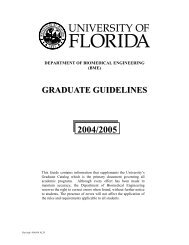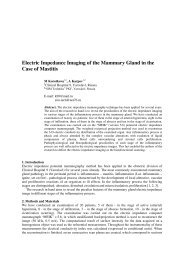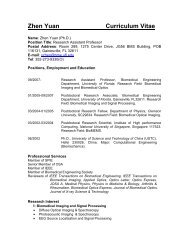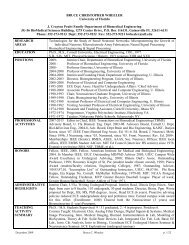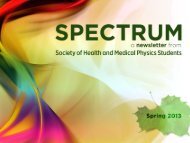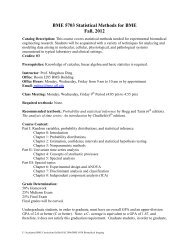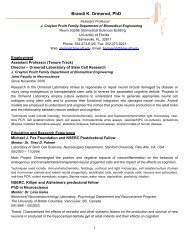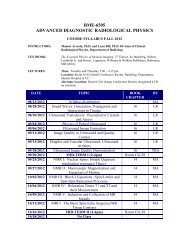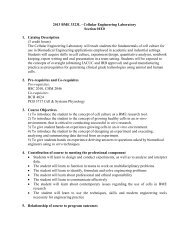Smirnov, A V; Nikolaev, D V; Kolesnikov, V A
Smirnov, A V; Nikolaev, D V; Kolesnikov, V A
Smirnov, A V; Nikolaev, D V; Kolesnikov, V A
You also want an ePaper? Increase the reach of your titles
YUMPU automatically turns print PDFs into web optimized ePapers that Google loves.
parallel; R500 and X500 are measured values of resistance and reactance at a frequency of 500 kHz;R500 and X500 are changes in resistance and reactance at a frequency of 500 kHz after eliminationof the capacitance C p influence on measured impedance; R50, X50 are similar changes at afrequency of 50 kHz.4. Discussion and conclusionsThe impedance plots shown in Fig. 2 for body segments of various resistances are similar to thosepublished by other authors [4, 5, 8]. The results of error analysis (Fig. 4) provide an opportunity toexplain the differences of impedance spectrum of different body segments. Satisfactory agreementbetween calculated and experimental error values suggests that such an explanation is correct.In case of body segments with the resistances over 200 Ohms an effect is prevalent of the low-passfilter of the impedances Z C3 , Z C4 and capacitance C 34 (Fig. 2a). In the resistance range 100–200 Ohms,change of polarity of the reactance measurement error takes place for the E1 electrodes caused by thepredominant effect of C 13 and C 24 capacitances that transmit voltage from the current generator outputdirectly to the voltage gauge. This leads to the shift of the high-frequency end of an impedance plot inpositive direction (Fig. 2b,c). In both ranges effects strongly depend on the contacts impedance. Othervalues of interelectrode capacities entail changes in the boundaries range.If absolute value of the impedance is less than 100 Ohms, then the positive error of the reactancemeasurement with electrodes E1 becomes so large that the measured value of the reactance X reversesits sign (Fig. 2d). The error of resistance R also reverses sign (Fig. 4a). The observed form of theimpedance locus is sometimes interpreted as the presence of an inductive component. But this effect isformed by joint action of the interelectrode capacities and contacts impedances. So, when measuredlow-resistant body segments, the electrodes contact impedance may produce unreliable results.For sufficiently large object resistances and small contact impedances the measurement providesreliable information on the object impedance. Table 1 show that the values of X500 are significantlyhigher than the absolute value of the expected error of the reactance when measured using E2electrodes (Fig. 4b). So, the capacitance C p is really present in measured impedance, and is not theresult of measurement errors. Representation of measured impedance as the parallel connection ofZ Cole and C p significantly improves an accuracy of approximation. Note also, that excluding of the C pcapacitance exerts little effect on the results of measurements at the frequency 50 kHz.Since the value of C p increases with the decrease of resistance of measured segment, one can drawconclusions about the nature of this capacity. Stray capacitance C s must increase with length and,hence, with the resistance of segment. Yet, the resistance and own capacity of a homogeneous objectare linked by obvious relation RC = , where is the resistivity, and the dielectric constant. Thus,the value of C p is determined primarily by the capacitive component of the biological objectimpedance Z B rather than by the stray capacitance C s .In conclusion, understanding the nature and properties of errors caused by contact impedances andinterelectrode capacitances gives a possibility to improve methods of calibration and measurements bythe correction of the influence of these elements.References[1] Cole K S 1932 J. Gen. Physiol. 15 641–649[2] Grimnes S, Martinsen O G 2000 Bioimpedance and Bioelectricity Basics (London: AcademicPress)[3] Gabriel S, Lau R W, Gabriel C 1996 Phys. Med. Biol. 41 2271–2293[4] De Lorenzo A, Andreoli A, Matthie J, Withers P 1997 J. Appl. Physiol. 82 1542–1558[5] Bolton M P, Ward L C, Khan A et al 1998 Physiol. Meas. 19 235–245[6] Grimnes S, Martinsen O G 2007 J. Phys. D:Appl. Phys. 40 9–14[7] <strong>Nikolaev</strong> D V, <strong>Smirnov</strong> A V, Bobrinskaya I G, Rudnev S G 2009 Bioelectric impedanceanalysis of human body composition (Moscow: Nauka)[8] Beckmann L, Cordes A, Saygili E et al 2009 IFMBE Proceedings 25/VII, 532–535



